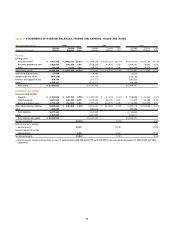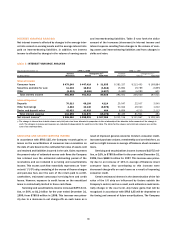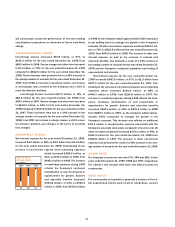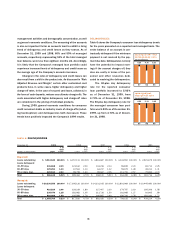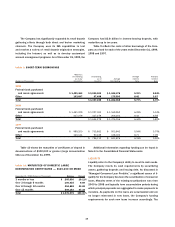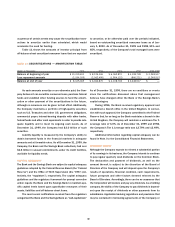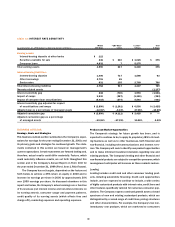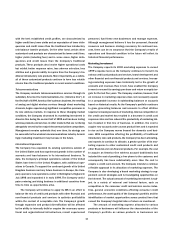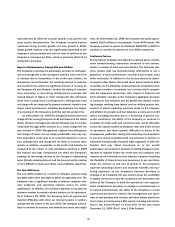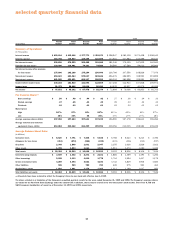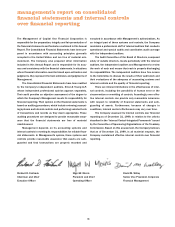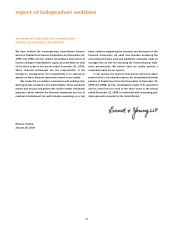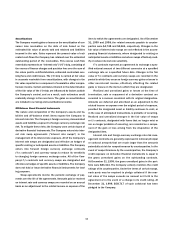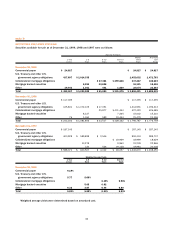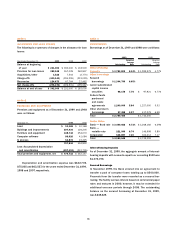Capital One 1999 Annual Report Download - page 44
Download and view the complete annual report
Please find page 44 of the 1999 Capital One annual report below. You can navigate through the pages in the report by either clicking on the pages listed below, or by using the keyword search tool below to find specific information within the annual report.
43
with the best established credit profiles, are characterized by
higher credit lines, lower yields and an expectation of lower delin-
quencies and credit losses than the traditional low introductory
rate balance transfer products. On the other hand, certain other
customized card products are characterized by lower credit lines,
higher yields (including fees) and in some cases, higher delin-
quencies and credit losses than the Company’s traditional
products. These products also involve higher operational costs
but exhibit better response rates, less adverse selection, less
attrition and a greater ability to reprice than the Company’s tra-
ditional introductory rate products. More importantly, as a whole,
all of these customized products continue to have less volatile
returns than the traditional products in recent market conditions.
Telecommunications
The Company markets telecommunications services through its
subsidiary America One Communications, Inc. (“America One”). In
the first half of 1999, America One’s primary business, the reselling
of analog and digital wireless services through direct marketing
channels, began experiencing significant competitive pressures in
its core wireless markets. In response to these changing market
conditions, the Company decreased its marketing investment in
America One during the second half of 1999 and has been testing
wireless products and services in other markets that are not being
adequately served by the major telecommunications competitors.
Management remains optimistic that, over time, its strategy can
be successful in the wireless telecommunications industry. Accord-
ingly, marketing investment may increase in the future.
International Expansion
The Company has expanded its existing operations outside of
the United States and has experienced growth in the number of
accounts and loan balances in its international business. To
date, the Company’s principal operations outside of the United
States have been in the United Kingdom, with additional oper-
ations in Canada. To support the continued growth of its United
Kingdom business and any future business in Europe, the Com-
pany opened a new operations center in Nottingham, England in
July 1998 and expanded it in early 1999. The Company antici-
pates entering and doing business in additional countries from
time to time as opportunities arise.
The Company will continue to apply its IBS in an effort to
balance the mix of credit card products with other financial and
non-financial products and services to optimize profitability
within the context of acceptable risk. The Company’s growth
through expansion and product diversification will be affected
by the ability to internally build or acquire the necessary opera-
tional and organizational infrastructure, recruit experienced
personnel, fund these new businesses and manage expenses.
Although management believes it has the personnel, financial
resources and business strategy necessary for continued suc-
cess, there can be no assurance that the Company’s results of
operations and financial condition in the future will reflect its
historical financial performance.
Marketing Investment
The Company expects its 2000 marketing expenses to exceed
1999’s expense level, as the Company continues to invest in its
various credit card products and services, brand development and
other financial and non-financial products and services. Increas-
ing marketing expenses have historically led to the growth of
accounts and revenues that, in turn, have enabled the Company
to meet or exceed its earnings per share and return on equity tar-
gets for the last five years. The Company cautions, however, that
an increase in marketing expenses does not necessarily equate
to a comparable increase in outstanding balances or accounts
based on historical results. As the Company’s portfolio continues
to grow, generating balances and accounts to offset attrition
requires increasing amounts of marketing. Intense competition in
the credit card market has resulted in a decrease in credit card
response rates and has reduced the productivity of marketing dol-
lars invested in that line of business. In addition, the cost to
acquire new accounts varies across product lines and is expected
to rise as the Company moves beyond the domestic card busi-
ness. With competition affecting the profitability of traditional
introductory rate card products, the Company has been allocating,
and expects to continue to allocate, a greater portion of its mar-
keting expense to other customized credit card products and
other financial and non-financial products. For example, the cost
to acquire an America One wireless account traditionally has
included the cost of providing a free phone to the customer, and
consequently has been substantially more than the cost to
acquire a credit card account. The Company intends to continue
a flexible approach in its allocation of marketing expenses. The
Company is also developing a brand marketing strategy to sup-
plement current strategies and is investigating opportunities on
the Internet. The actual amount of marketing investment is sub-
ject to a variety of external and internal factors, such as
competition in the consumer credit and wireless service indus-
tries, general economic conditions affecting consumer credit
performance, the asset quality of the Company’s portfolio and the
identification of market opportunities across product lines that
exceed the Company’s targeted rates of return on investment.
The amount of marketing expense allocated to various
products or businesses will influence the characteristics of the
Company’s portfolio as various products or businesses are


